Evolution MR evolves into car for all seasons
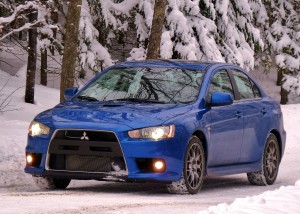
Snow-laden trees and icy roads were no match for the Mitsubishi Evolution MR -- with the right tires.
By John Gilbert
Wintertime can be a great equalizer. Especially when it’s extreme, like the winter of 2010-2011, which is setting records all across the Upper Midwest for snowfall and cold temperatures. But after all, what else is there to extreme winter but snow and cold? In the automotive world, virtually every car produced has enough good features to impress most people, but a lot of cars come up startlingly short when asked to perform in the worst winter conditions.
Then there is the Mitsubishi Evolution MR. The Evolution is a basic Lancer compact that has been thoroughly upgraded for high performance in every way, starting with a sizzling hot turbocharged engine and adding high-end components, improved beyond reasonable limits, to make sure all the parts can keep up with the performance generated by that engine.
When I first heard I was going to get a 2011 Evolution for a week between Christmas 2010 and New Year’s 2011, I was concerned about its driveability in that particular week, because Minnesota had been blanketed with a 10-inch snowfall on top of a sleet-formed ice base. I knew the Evolution has all-wheel drive, and I knew it is one of the most spectacular cars to drive on dry pavement, but I wondered if the all-wheel drive would simply mean all four wheels would spin rapidly while the car stayed in the same place.
My worries were put to rest immediately. The car was delivered wearing Dunlop Wintersport SP tires, instead of the summer high-performance rubber. To my great surprise, the car with those tires stuck on snowy and icy roads almost as impressively as the sticky summer performance tires make it stick to a road or racetrack.
As the week went on, I left Minneapolis and St. Paul behind to venture 150 miles north, to drive the Evolution in Duluth, Minnesota, going up against that long and narrow cliff-side city where scaling a dozen blocks of 30-degree grade is more than just a challenge; it’s required, for anyone who wants to hit the major shopping area, the university, or get to the airport.
Child’s play. Except no child could have any more fun than our family had driving the Mitsubishi Evolution MR to cavort on icy streets and highways, and through snowdrifts wherever we could find them.
The heart of the Evolution is a 2.0-liter, dual-overhead-camshaft “MIVEC” 4-cylinder engine, turbocharged to produce 291 horsepower and 300 foot-pounds of torque. MIVEC means Mitsubishi Innovative Valvetrain Electronic Control, and to distribute that power to all four wheels, you can stir a 5-speed manual transmission, although I must say, the stick is not required to extract the most fun from the car. Choose the 6-speed automatic, because it’s not an automatic at heart, but another dabble into acronyms as the TC-SST. That stands for Twin Clutch Sportronic Shift Transmission.
It’s a clutchless manual, a twin-clutch gearbox where the first clutch grabs first, third and fifth, and the second clutch finds second, fourth and sixth. Shifting means you alternate between clutches, although you never realize anything except that it shifts with smooth and seamless changes in tone. When you want to run hard, the revs build in one gear to notify the computer that you’re going to upshift, so the other clutch engages the next gear, and as soon as you click the long and elegant magnesium paddle with your right hand’s fingertips, the enclosed transmission switches from one clutch to the other to instanly put you in the next-higher gear. Let’s just say that it changes gears faster than anyone could shift a stick, and certainly faster than anyone could say “TC-SST.”
The paddle on the left is for downshifting, and the beauty of those paddles is that they are affixed to the steering column, not the steering wheel, so that if you run out of revs as you go around a sharp corner, you needn’t grope for the paddle on the steering wheel, just reach for it in its familiar and fixed location.
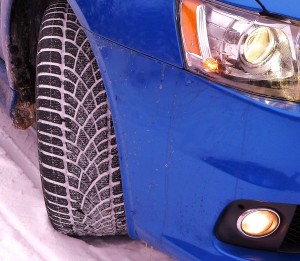
Aggressive tread pattern and compound on the Dunlop Wintersport SP tires worked well on snow and ice.
But here’s the bigget news about that slick-shifting beauty: The fastest and most impressive way to upshift or accurately downshift is to just leave the thing in “D” for drive. That’s right, it upshifts with eerie precision, and it downshifts exactly where it should, blipping the throttle in a rev-matching instant as it downshifts once or twice, reading the yaw sensor to determine how sharp the curve is. While that seems disturbing or outrageous to any performance driver worth his stick-shift, the upside is that you keep your hands on the steering wheel and your complete concentration on actually steering and driving. The car takes care of the shifting, and it can do it better than any driver.
There is much more to the Evolution than the great engine and the inventive transmission. There is even more than the fantastic MR suspension, which adds Eibach springs to the MacPherson strut front and multilink rear suspension, with Bilstein shocks on all four corners. That keeps the car flat and stable on the tightest and most abrupt turns and corners, just as the oversized Brembo brakes stop the car on a proverbial dime — which, we all know, isn’t as big as it was when the proverb was invented.
Ready or not, let’s go to another acronym, S-AWC, for Super All-Wheel Control, which activates the all-wheel-drive system with yaw control to dispense extra power to either the left or right rear for optimum stability. Any spinning changes how much torque is sent to which axle, and you can actually alter what percentage of the power goes to the rear for normal driving, as well.
A small switch on the console, next to the shift lever, can be switched to Normal, Sport, or Super-Sport. The normal setting is very good for every situation, and you have no need for the sport setting — unless and until you try it. Switching to sport prompts the computer to hold the revs much higher, closer to the engine’s 7,000-RPM redline, and it both upshifts and downshifts more aggressively for more high-performance driving. It doesn’t bother giving you sixth gear, using the better torque of the first five for its duties. Anyone trying the super-sport setting would be best-advised to be on a racetrack.
Mechanically, then, the Evolution MR has an engine, transmission, suspension, steering system, all-wheel-drive system, and brakes that are sufficient to make it an all-out performance car, and all that high-end stuff makes its seemingly steep sticker price of $34,755 distinctly reasonable. Even if you loaded up all the creature features from the option bin and got it up to $40,000, you realize that if you started with the basic Lancer and did all the work yourself you would spend twice that. It’s simply a bonus that when you add very good winter performance tires, you can have your pocket rocket and enjoy driving it in the wintertime, too.
Inside the 4-door sedan, there are more features to enhance driving pleasure. Genuine Recaro bucket seats up front grab you in a vice-like hold and support your lower back and thighs wherever they need to be supported. The instrumentation reminds you of a high-performance motorcycle in their ease of being understood at a glance. The audio system has a Rockford-Fosgate upgrade that seems to rival the power of the engine, almost. Almost, being the operative word.
The dash is brushed silver accenting basic black. There is a switch on the lower left of the tastefully simple dash that lets you adjust the aim of your headlights, even. That is helpful to make sure the low-beam’s razor-sharp cutoff is below eye-level of approaching traffic. Switching to high beams creates something better than daylight, the better to spot those unpredictable deer that might venture out on the road to see what all that brightness is about.
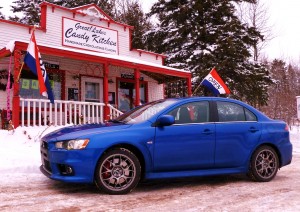
The Evolution beat the Dec. 31 winter closing date of the "Great! Lakes Candy Kitchen" in Knife River, MN.
Mitsubishi has not enjoyed the hot-selling success of Japanese rivals such as Honda, Toyota, or Nissan, but the company continues to make worthy cars and small SUVs, including the compact Lancer sedan and the Outlander crossover SUV. The prize of Mitsubishi’s stable, though, is the Evolution MR, which takes the basic Lancer to race-ready levels of performance and handling that few consumers will ever experience.
Automotive magazine articles and reviews written from warm-weather areas would have us believe that to be considered performance-worthy, a car must have its engine in the front and its drive wheels at the rear. Those of us in the Great Midwest know better. We have what they call “seasons,” and among those seasons is “winter.” True, it is possible to get through winter with a rear-drive car, and a rear-drive car with top winter tires might handle better than a front-drive car with bad winter tires, but putting proper tires on a front-drive car closes the case. When we face a drive with snow or ice covering the highway, the rear end tends to want to pass the front on any rear-drive car, none of which can approach the warm and fuzzy security of any front-drive car with proper tires. All-wheel-drive adds another level of security.
But during a lifetime of driving in winters, learning why some cars scale icy hills better than others, I never anticipated that a high-performance car like the Mitsubishi Evolution MR could be as exhilharating to drive in a blizzard as it is around a racetrack in the middle of summer. Even in the midst of a 16-inch blizzard, or a plunge to 30 below zero, enthusiasts can consider a new motto: “Don’t start the Evolution without me!”
Comments
Tell me what you're thinking...
and oh, if you want a pic to show with your comment, go get a gravatar!


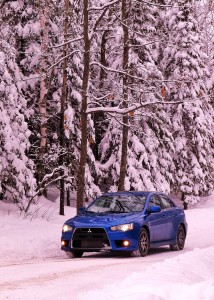
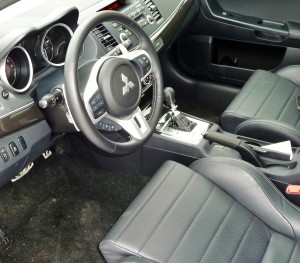
 John Gilbert is a lifetime Minnesotan and career journalist, specializing in cars and sports during and since spending 30 years at the Minneapolis Tribune, now the Star Tribune. More recently, he has continued translating the high-tech world of autos and sharing his passionate insights as a freelance writer/photographer/broadcaster. A member of the prestigious North American Car and Truck of the Year jury since 1993. John can be heard Monday-Friday from 9-11am on 610 KDAL(www.kdal610.com) on the "John Gilbert Show," and writes a column in the Duluth Reader.
John Gilbert is a lifetime Minnesotan and career journalist, specializing in cars and sports during and since spending 30 years at the Minneapolis Tribune, now the Star Tribune. More recently, he has continued translating the high-tech world of autos and sharing his passionate insights as a freelance writer/photographer/broadcaster. A member of the prestigious North American Car and Truck of the Year jury since 1993. John can be heard Monday-Friday from 9-11am on 610 KDAL(www.kdal610.com) on the "John Gilbert Show," and writes a column in the Duluth Reader.